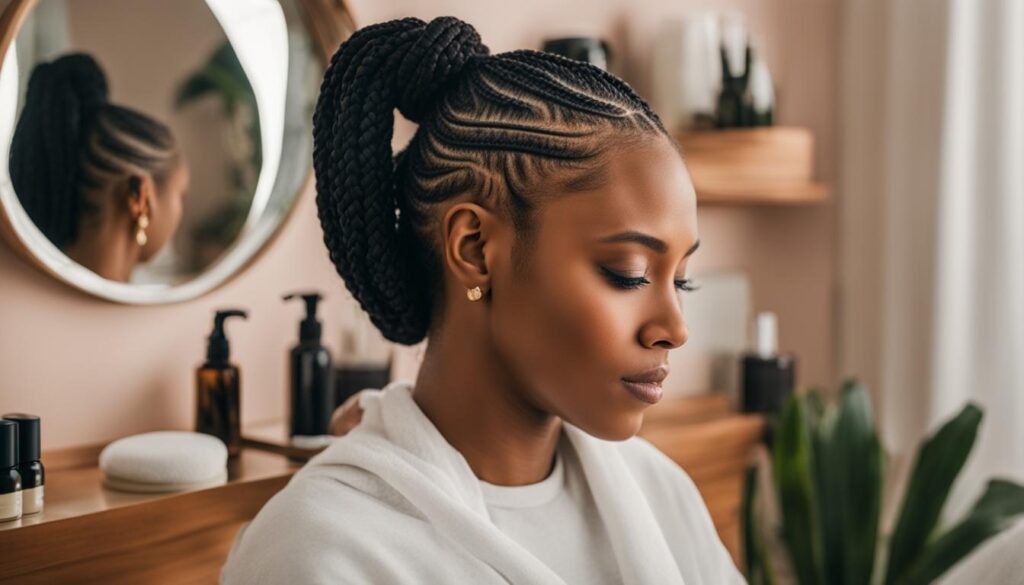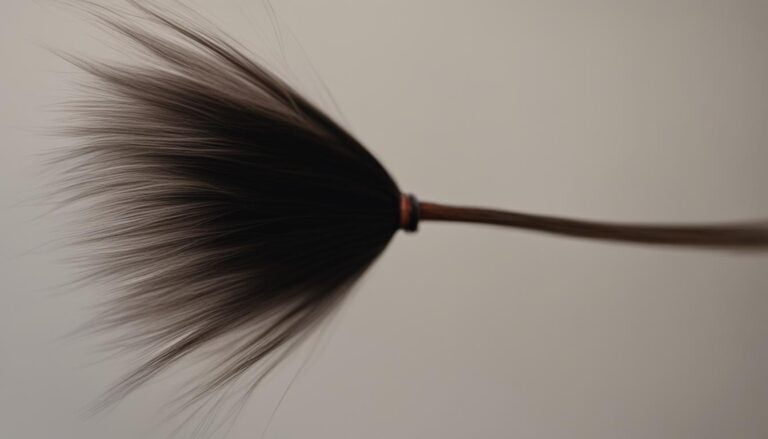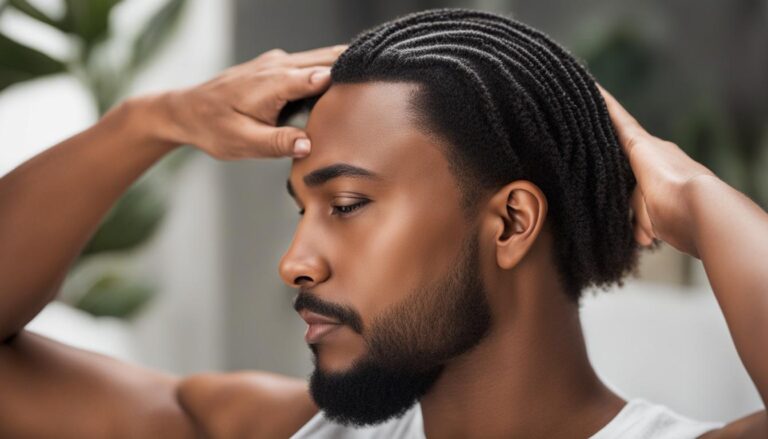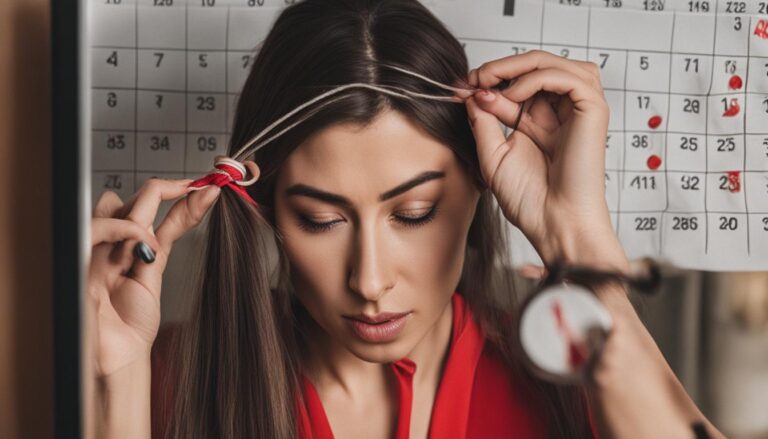Do Cornrows Damage Hairline?
Cornrows, a popular braided hairstyle, have recently made a comeback. While they may be trendy, cornrows can actually cause damage to the hairline. Tight braided hairstyles, including cornrows, can lead to a condition called Traction Alopecia, which causes hair loss and thinning around the hairline. This condition is most common among African American women and can result from the prolonged and constant tension placed on the hair follicles. It is important for individuals, especially women of color, to understand the potential risks of cornrows and take steps to protect their hairline.
Key Takeaways:
- Tight braided hairstyles like cornrows can cause damage to the hairline.
- Traction Alopecia is a common condition resulting from the constant tension placed on the hair follicles.
- Cornrows can lead to hair loss and thinning around the hairline, particularly in African American women.
- Moisturizing the hair, avoiding excessive tension, and practicing proper hair care can help prevent hairline damage from cornrows.
- It is important to be mindful of the potential risks and strive to maintain hair health when wearing cornrows.
The Link Between Cornrows and Traction Alopecia
Traction Alopecia is a major concern when it comes to cornrows and hairline damage. This condition is caused by the continuous pulling force exerted on the hair follicles when wearing tight hairstyles like cornrows. The pressure and tension can lead to hair loss and thinning, particularly around the hairline. Cornrows put additional stress on the hair follicles, leading to damaged follicles and an increased risk of Traction Alopecia.
When it comes to understanding how cornrows cause hair loss, it’s important to recognize the effect of tight hairstyles on the hairline. The constant tension and pulling on the hair follicles can cause follicle damage and hair loss over time. The weight of added extensions or wefts in cornrows can further strain the hairline, exacerbating the risk of hairline damage.
Experts believe that the tightness of the braids, combined with the lack of air and moisture circulation, can contribute to a dry scalp and increased risk of fungal infections. Additionally, leaving cornrows in for an extended period or repeatedly re-braiding them can worsen the damage to the hairline. These factors all play a role in the link between cornrows and Traction Alopecia.
Effects of Tight Hairstyles on the Hairline:
- Constant tension and pulling on hair follicles
- Follicle damage and hair loss
- Weight of added extensions or wefts
- Strain on the hairline
- Lack of air and moisture circulation
- Dry scalp and increased risk of fungal infections
Understanding the link between cornrows and Traction Alopecia is crucial in order to prevent hairline damage. By being aware of the effects of tight hairstyles on the hairline and taking measures to minimize tension, individuals can reduce the risk of hair loss and thinning associated with cornrows. Additionally, maintaining a healthy scalp through proper cleansing and moisturizing can help prevent fungal infections and promote overall hair health.
Factors Contributing to Hairline Damage from Cornrows
Wearing cornrows can be a stylish and convenient choice, but it’s important to be aware of the factors that can contribute to hairline damage. Understanding how cornrows affect the hairline can help you take the necessary precautions to protect your hair.
One of the main reasons cornrows can damage the hairline is the constant tension and pulling on the hair follicles. The tight braids exert pressure on the follicles, which can lead to hair loss and thinning around the hairline. Additionally, the weight of added extensions or wefts can further strain the hairline.
Another factor to consider is the tightness of the braids. When cornrows are tightly braided, it restricts air and moisture circulation to the scalp. This can result in a dry scalp, which increases the risk of fungal infections. Leaving cornrows in for an extended period or repeatedly re-braiding them can exacerbate the damage to the hairline.
To minimize hairline damage from cornrows, it’s important to choose a looser braiding technique and avoid excessive tension on the hair. Keeping the scalp and hair moisturized can also help maintain a healthy hairline. Regularly washing the scalp and taking breaks between cornrow hairstyles can prevent dryness and allow the hair follicles to recover.
Symptoms and Risks of Traction Alopecia
Traction Alopecia, a condition often associated with tight hairstyles like cornrows, can present with various symptoms that indicate hairline damage. Recognizing these symptoms is crucial in taking timely action to prevent further hair loss and promote hairline health.
Common signs of Traction Alopecia include hair loss around the hairline, particularly near the forehead, as well as the appearance of thin and broken hair in the affected area. Individuals may also experience bumps or blisters on the scalp, itching, scaling, and even folliculitis. Additionally, redness, stinging, or soreness of the scalp are potential indicators of hairline damage.
If left untreated, Traction Alopecia can lead to permanent hair loss and bald patches. The continuous pulling and tension on the hair follicles from tight hairstyles like cornrows can cause irreparable damage. Therefore, it is crucial to be aware of the risks associated with Traction Alopecia and take proactive steps to prevent further hairline damage.
“Symptoms of Traction Alopecia, such as hairline thinning and breakage, should not be ignored. Addressing the issue promptly can help prevent irreversible damage.” – Dr. Haircare Specialist
Effects of Tight Hairstyles on Hair
Tight hairstyles, including cornrows, can have detrimental effects on the hair and scalp. Constant tension and pulling on the hair follicles can weaken them over time, leading to hair loss and thinning, particularly around the hairline. The weight of added extensions or wefts in cornrows can further strain the hairline and exacerbate hairline damage.
In addition to hair loss, tight hairstyles restrict air and moisture circulation to the scalp, which can result in a dry scalp and increase the risk of fungal infections. The prolonged wear of cornrows or frequent re-braiding can also contribute to worsened hairline damage. It is important to understand these effects and take appropriate precautions to protect the hairline when wearing tight hairstyles like cornrows.
- Recognize the symptoms of Traction Alopecia to identify hairline damage early.
- Take proactive steps to prevent further hair loss and promote hairline health.
- Avoid tight hairstyles and excessive tension on the hairline.
- Maintain a healthy scalp by regularly washing and sanitizing, preventing fungal infections.
- Consult a professional for personalized treatment options if hairline damage occurs.

By understanding the symptoms and risks of Traction Alopecia, individuals can take the necessary precautions to protect their hairlines while still enjoying trendy hairstyles like cornrows. Early recognition of hairline damage and proper hair care can make a significant difference in maintaining hair health and preventing further hair loss.
Preventing Hairline Damage from Cornrows
When it comes to cornrows, protecting your hairline is essential to avoid potential damage. By following a few simple steps, you can maintain the health of your hair while still rocking this popular hairstyle.
First and foremost, it’s crucial to moisturize your hair before braiding. Applying a leave-in conditioner or natural oils, such as coconut or argan oil, can help hydrate your hair and prevent breakage. Make sure to pay extra attention to the edges and hairline area, as they are most susceptible to damage.
Next, opt for a looser braiding technique. Avoid pulling the hair too tightly or creating excessive tension on the follicles. This will help minimize the strain on your hairline and reduce the risk of traction alopecia.
Steps to Avoid Hairline Damage with Cornrows
- Moisturize your hair before braiding to prevent breakage
- Opt for a looser braiding technique to reduce tension on the hairline
- Avoid leaving cornrows in for extended periods
- Take breaks between cornrow hairstyles to allow your hairline to relax
- Regularly wash and sanitize your scalp to prevent fungal infections
Lastly, it’s important to practice proper hair care while wearing cornrows. Regularly wash and sanitize your scalp to prevent fungal infections that can damage your hairline. Avoid leaving cornrows in for extended periods and make sure to take breaks between hairstyles to give your hairline a chance to rest and recover.
By following these simple preventive measures, you can minimize the risk of hairline damage and keep your hair healthy and fabulous while wearing cornrows.
Treatment Options for Hairline Damage
If you’ve experienced hairline damage from wearing cornrows, there are treatment options available to help restore and regrow your hairline. It’s important to address the issue early on to prevent further damage and promote healthy hair growth. Here are some treatment options to consider:
1. Traction Alopecia Treatment:
Since Traction Alopecia is the primary concern when it comes to hairline damage from cornrows, specific treatments targeting this condition can be beneficial. Look for specialized shampoos and lotions that promote hair regrowth and prevent further hair loss. These products often contain ingredients like minoxidil or finasteride, which can help stimulate hair follicles and promote new hair growth.
2. Natural Remedies:
There are also natural remedies that can aid in regrowing your hairline. Scalp massages are a simple and effective way to improve blood circulation to the hair follicles, promoting growth. Additionally, a healthy diet rich in vitamins and minerals, such as biotin, vitamin E, and iron, can provide the necessary nutrients for hair health. Essential oils like coconut or rosemary oil can also nourish the scalp and stimulate hair growth.
3. Professional Intervention:
In severe cases of hairline damage, seeking professional intervention may be necessary. A dermatologist or trichologist can provide personalized treatment options based on your specific condition and needs. They may recommend medications, such as corticosteroids or immunosuppressants, to reduce inflammation and encourage hair growth. In some cases, surgical procedures like hair transplants or scalp micropigmentation can be considered to restore the hairline.
Remember, it’s essential to consult a professional before starting any treatment regimen to ensure it is suitable for your specific situation. They can provide guidance and monitor your progress to achieve the best possible results. With the right treatment approach, you can restore your hairline and regain confidence in your appearance.

Maintaining Healthy Hair with Cornrows
When it comes to rocking cornrows, it’s essential to prioritize the health of your hair. By following a few simple tips and tricks, you can maintain a healthy mane while wearing this stylish braided hairstyle. Here are some key steps to protect your hair and preserve your hairline with cornrows:
Amp up your hair care routine:
Start with clean and conditioned hair before getting your cornrows done. Use a moisturizing shampoo and conditioner to keep your hair hydrated and nourished. Remember to focus on your scalp as well, keeping it clean and free from product buildup. This will help ensure optimal hair health while rocking cornrows.
Avoid excessive tension:
Tight braids can put unnecessary strain on your hairline and lead to damage over time. Opt for a looser braiding technique and communicate with your stylist about your comfort level. This will help minimize the tension on your hair and reduce the risk of hairline damage.
Protect your hair while wearing cornrows:
While cornrows look stunning, they can be harsh on your hair if not properly cared for. Avoid using heat styling tools and harsh chemicals on your hair while it’s in cornrows. This will help prevent breakage and keep your hair healthy and strong. Additionally, protect your hair from UV rays by wearing a hat or using a hair product with UV filters.

Maintain a healthy hairline:
Preserving your hairline is crucial when wearing cornrows. Take breaks between hairstyles to allow your hairline to recover and minimize the risk of tension-related damage. Be gentle when washing and brushing your hair, paying extra attention to your hairline. Regular trims to prevent split ends and breakage can also help maintain a healthy hairline.
By following these tips and incorporating them into your hair care routine, you can keep your hairline intact and maintain healthy hair while rocking cornrows. Remember to listen to your hair and give it the love and attention it deserves.
Conclusion
After careful consideration, it is clear that cornrows can indeed cause hairline damage and increase the risk of Traction Alopecia. The tight braiding technique and constant tension on the hair follicles can lead to hair loss and thinning around the hairline, particularly among African American women. However, by taking preventive measures and practicing proper hair care, individuals can mitigate the potential risks and protect their hairline while rocking this popular hairstyle.
To protect your hairline while wearing cornrows, it is important to moisturize your hair and seal the ends with oil before braiding. Choosing a looser braiding technique and avoiding excessive tension can help reduce strain on the hairline. Regularly washing and sanitizing your scalp can prevent fungal infections and maintain a healthy hairline. Additionally, it is essential to avoid leaving cornrows in for extended periods and take breaks between cornrow hairstyles to allow your hairline to rest and recover.
While cornrows may be fashionable, it is crucial to prioritize hair health and understand the potential risks involved. By following these preventive measures and maintaining a proper hair care routine, you can enjoy the beauty of cornrows without compromising the health of your hairline. Remember, protecting your hairline is essential for preserving the longevity and overall health of your hair.
FAQ
Do cornrows damage the hairline?
Yes, tight braided hairstyles like cornrows can cause damage to the hairline.
How do cornrows lead to hairline damage?
Cornrows put constant tension on the hair follicles, leading to a condition called Traction Alopecia, which causes hair loss and thinning around the hairline.
What factors contribute to hairline damage from cornrows?
Factors include constant tension and pulling on the hair follicles, the weight of added extensions or wefts, lack of air and moisture circulation, and leaving cornrows in for an extended period or repeatedly re-braiding them.
What are the symptoms and risks of Traction Alopecia?
Symptoms include hair loss around the hairline, bumps or blisters on the scalp, itching, scaling, and folliculitis. If left untreated, Traction Alopecia can cause permanent hair follicle damage and bald patches.
How can I protect my hairline while wearing cornrows?
You can moisturize the hair and seal the ends with oil before braiding, choose a looser braiding technique, regularly wash and sanitize the scalp, avoid leaving cornrows in for extended periods, and take breaks between cornrow hairstyles.
Are there treatment options for hairline damage from cornrows?
Yes, options include specialized shampoos and lotions to promote hair regrowth and prevent further hair loss, scalp massages, a healthy diet, and the use of essential oils.
How can I maintain healthy hair with cornrows?
Start with clean and conditioned hair, use a gentle braiding technique, avoid tightness, regularly wash and brush the hair, protect the hair from harsh treatments and UV rays, get regular trims, and incorporate essential oils into the haircare routine.
What is the conclusion regarding cornrows and hairline damage?
While cornrows can cause hairline damage if not properly cared for, taking preventive measures can help protect the hairline and maintain healthy hair while wearing this style.







